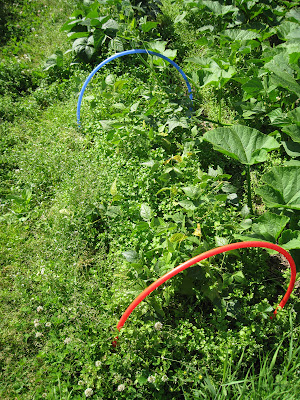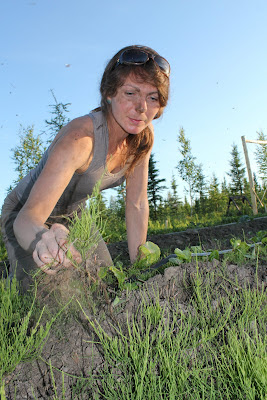by Laura Emerson, an Alaskan Master Gardener
 |
| Chickweed overtakes this garden. Photo by Heidi Rader. |
Weeds get a bad rap. But for the observant gardener,
weeds can be a wonderful resource. Many
offer clues to the condition of the soil before you buy that expensive plant
that will not do well where you want it. Many
deliver minerals to the vicinity of their growth or to your compost pile or to
your pets and livestock or to you, if you choose to eat them.
Many
have or are reported to have homeopathic benefits. So, in
defense of weeds, I offer the following evidence for four plants, chickweed,
dandelions, horsetail, and yarrow. I invite other Master Gardeners to add to this list and information.
Chickweed:
This low, soft, tangly mass of weeds with a shallow root system is pretty innocuous and easy to weed. Because it likes areas that are tilled, cool, and well watered, it tends to grow in or next to my gardens and hoses. Its Latin name, stellaria media, may refer to the tiny white flowers that appear in late summer and look like tiny stars. Its common name indicates that chickens (and other birds) like to eat it, although, my chickens far prefer ferns and grass seed heads growing in the yard at the same time.
Good news in the garden: Chickweed has a lot of minerals, and since it is such a spindly plant, it returns those to the soil when it decomposes. If you don’t want it where it is growing, compost it. It degrades quickly.
Bad news in the garden: It grows fast and will spread through a garden in mid-summer (South Central AK), shading the ground and holding moisture. (On the other hand, it covers areas that other windblown weeds might seed then).
Good news out of the garden: Chickweed is high in vitamin C and several other minerals. It can be eaten raw, as in salads, or cooked, or made into a tea (2 TBS to 1 cup boiling water). I don’t care for the taste raw (it is like eating grass) but I actually like it as a tea (a gentle spicy flavor, perhaps analogous to fennel). I have found it effective in external topical uses. Macerated or boiled and strained, I have made a poultice to sooth my husband’s skin where he has been bitten by insects, as chickweed is supposed to “pull out” the infection. Ewell Gibbons practically yodeled about all the benefits of this plant.
Dandelions:
Even the most urban, non-gardener recognizes these bright yellow flowers arising out of a xx of flat, toothy leaves. In fact, the name means, “the lion’s tooth.” In South Central Alaska, they have two periods of growth and seeding, so they spread particularly fast.
Good news in the garden: Dandelions indicate good deep soil, and their strong, deep tap root (up to three feet long) offers two advantages to its vicinity. It penetrates hardpan, which less hardy plants can’t, and brings nutrients like calcium and iron up from those depths to the surface soil that may have lost it, for example, by erosion or construction pressure. The deep root system also attracts earthworms, which accomplish more good work by further loosening the packed soil. Because I know I have a calcium deficiency in my yard, and know from the shape of the land that erosional factors have long been at work, I let dandelions grow for two seasons and now just clip the flowers to reduce further spread but appreciate all the hard work they do! Because of their deep roots, they do not compete with neighboring plants, like grass for shallow soil benefits but…
Bad news in the garden: Dandelions, like apples and some other plants, emit ethylene gas which may inhibit the growth of neighboring plants and may cause them to flower or fruit sooner (which could be a plus, too).
Good news out of the garden: Early dandelion leaves are very tasty. I tend to cook them in olive oil and garlic to serve with pasta instead of spinach. Like any leafy greens, they cook down quite a bit, so you should collect more than you may think. I have never tried to make dandelion wine, but probably like you, have heard of it. Apparently a gallon of the wine would require 2-4 quarts of the yellow flowers! The Latin name, Taraxacum officinale, may indicate how widely and well it was regarded as a medicine. Apparently it was widely used (particularly root extracts) in many patent remedies,
particularly for liver and kidney stimulation, and a general tonic.
Ferns:
Good news for the garden: Ferns indicate a phosphorus deficiency but they, themselves, contain it. So (a) check which plants you want to grow there! (Examples?) and (b) cutting and mulching those plants in the same setting will reintroduce the phosphorus needed for a better balanced ecosystem. They grow in moist and usually wooded areas. References to “bracken” in English novels indicate ferns. Composted, ferns help with tree seeding.
Bad news for the garden: Shield and soldier ferns here grow rapidly. The latter grow to a height over 6 feet, shading out most anything beneath, creating high hummocks of root stock.
Good news out of the garden: My chickens LOVE fresh ferns, either on the stalk or brought to them. The fiddleheads (early growth) are edible by humans IF COOKED but ferns may be detrimental, eaten raw. I scuff off the brown scales with my fingers, rinse under water, and then saute in garlic butter. Reported homeopathic uses for shield fern (dryopteris dilatata) include boiling it and then applying it to the eyes or drinking it as a tea for various internal stomach, intestinal, kidney ailments. However, some ferns are discouraged for human consumption, certainly raw, I understand, because they interfere with thiamine consumption.
Horsetail:
 |
| Heidi Rader weeds Horsetail from her garden. Photo by Chris Cannon. |
Horsetail
(the Latin name is equisetum) is one of the last survivors of huge, ancient trees
that reproduced by spores (like ferns), not seeds. The stems are hollow and jointed, like a soft
bamboo. Growing 1-4 feet tall, they are
also called “meadow pines” because of the side shoot “bristles.”
One source
says they like moist places, another sites gravely/sandy sites with a high
water table. On my hilly property, I
find them in greatest profusion down low, close to the lake but also numerous
in a higher, drier meadow.
Good news in the garden:
Horsetail is easy to cut above ground, but it
is difficult to eradicate below ground. The plants contain a high percentage of silica but touching it doesn’t sting, like nettles, which are also high in it. A silica spray made of horsetail and water is effective against fungus, mildew and various beetles, weevils, and larvae without harming the desirable plants. The spray may also strengthen the plants. It is a good addition to the compost pile. Fresh, my chickens like to nibble on it.
Bad news in the garden: Where they grow, they form dense thickets, shading out alternatives you might prefer for ground cover or in the garden.
Good news out of the garden: As a medicine, horsetail has been used in various preparations to stop external bleeding, mouth sores, and to strengthen tissues.
Yarrow:
Good news in the garden: I like its light, flat white cyme (like an umbel of tiny flowers) on tall stalks above soft, ferny leaves that spread and keep out other weeds that want to encroach on the same sunny segment of yard (like hemp nettle). Yarrow flowers throughout the summer in South Central Alaska. The flowers have a slightly medicinal scent (up close), so they are said to deter voles and other critters you might not want near a door and to make nearby plants more insect resistant (but that may require more than my small group of plants). Where I transplanted yarrow in shady spots, it’s growth was unimpressively spindly and leggy, but in the sunny part of the yard, it has expanded with shorter and hardier plants. What I have read and what I hope is that if it does take over the side yard, cutting it low will create a soft green and white ground cover. Sounds nice!
Bad news in the garden: Yarrow spreads through underground runner roots. If you don’t like it, you’ll need to dig an enlarged area to eradicate it. By the end of the second full year, the roots of transplanted ones are tangled and, in some cases, as deep as a shovel’s spade.
Good news out of the garden: Yarrow is also called “soldier’s woundwort” because it grew in fields where battles were historically conducted, and because its leaves were often applied to staunch the blood of fallen soldiers. Its Latin name is (a) Achillea (b) millefolium because (a) Homer reported Achilles using it for this purpose on the ancient battle fields of Ilium (written around 800 BCE) and because (b) of its thousands of feathery leaves growing from a central rosette. I myself have used it for wound healing and found it more effective than gauze. For example, I cut off the tip of my finger with a kitchen madeleine, a bloody wound. The gauze pressure worked when on, but the bleeding recommenced every time I changed the dressing. The third day, I boiled yarrow leaves, strained them, and then applied them to the wound, like a little salad, surrounded by a “crown” of bandage to keep me from touching the tip inadvertently, and to give air to the injury. This worked well. No infection, and limited scarring. Many other medicinal attributes are identified for such a well regarded ancient plant. I have tried drinking its tea and found it pretty unpalatable, but I have found a poultice of boiled leaves soothing on insect bites and other skin sores.
Resources: The sources of much of the content above are: Alaska’s Wilderness Medicines: Healthful Plants of the Far North, by Eleanor G. Viereck and Carrots love Tomatoes & Roses love Garlic, by Louise Riotte.
Share this.


thanks for the weed info. i am also trying to get to know a weed similar in look to the horsetail. i cant figure out what it is. can i pm you a foto to id ? Libby